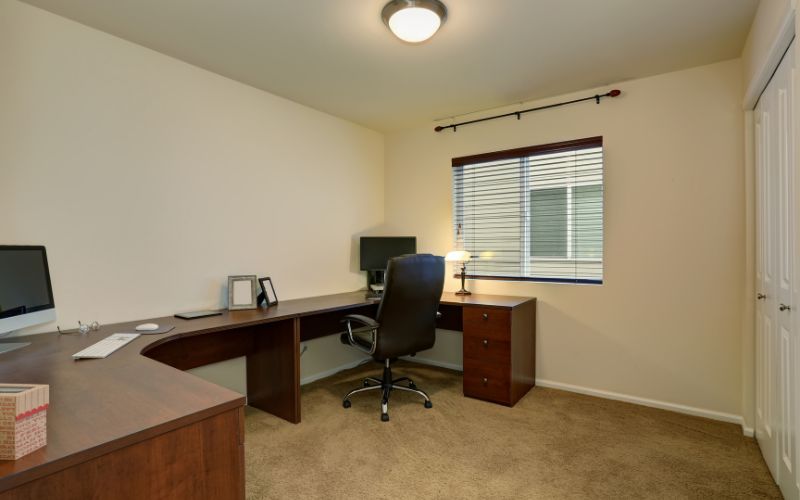Ergonomics Problems
Poor Office Furniture Design
Unsuitable office furniture is a prevalent ergonomic issue that leads to various health problems, such as neck pain, back pain, and shoulder pain.
Furniture not designed keeping in mind the comfort and safety of the user is the root cause of these issues.
For instance, a chair lacking lumbar support results in back pain, and a desk that is too high or low can result in improper posture leading to long-term health problems.
Inadequate Lighting
Inadequate lighting is another common ergonomic issue that can cause eye strain and headaches, leading to decreased productivity and increased stress levels.
A workplace with inadequate lighting can make it challenging to see the computer screen or tasks, causing employees to squint and leading to eye strain and headaches.
Uncomfortable Chairs
Uncomfortable chairs are a leading cause of various ergonomic problems, including back pain, neck pain, and shoulder pain.
Chairs that are too hard or soft, lack lumbar support, or are not adjustable can lead to discomfort and improper posture, resulting in long-term health problems.
You should invest time in choosing the best ergonomic chair for you.
Ergonomic problems – Incorrect Posture While Sitting or Standing
Incorrect posture while sitting or standing is a prevalent ergonomic issue that results in various health problems, including back pain, neck pain, and shoulder pain.
Poor posture can lead to decreased productivity and increased stress levels.
Maintaining good posture is vital for comfort and health, as it reduces the risk of injury and promotes good circulation.
Repetitive Motions
Repetitive motions, such as typing or extended use of a mouse, can result in repetitive strain injuries (RSIs) such as carpal tunnel syndrome.
RSIs cause pain, numbness, and tingling in the hands, arms, and shoulders, affecting an individual’s ability to work and complete everyday tasks.
Poor Workspace Organization
Poor workspace organization is another common ergonomic issue that results in various health problems, including back pain, neck pain, and shoulder pain.
Cluttered workspaces make it challenging to find what you need, leading to repetitive motions and poor posture, increasing stress levels.
Lack of Movement or Breaks During the Workday
A lack of movement or breaks during the workday is another common ergonomic issue that results in various health problems, including back pain, neck pain, and shoulder pain. Sitting or standing in the same position for extended periods can lead to discomfort and poor posture, increasing stress levels. Regular breaks to move and stretch can help alleviate these problems and promote good health and well-being.
Identifying Ergonomics Problems
Identifying ergonomic problems in the workspace is crucial to prevent them from becoming a source of pain and discomfort.
Pay attention to any pain or discomfort you feel while working, observe your posture and movements, check your workspace for ergonomic equipment, and look for signs of repetitive motion injuries.
Solutions for Common Ergonomics Problems
Once you’ve identified ergonomic problems in your workplace, it’s time to Invest in ergonomic office equipment, such as an ergonomic keyboard, mouse, and wrist rest, to reduce the risk of repetitive strain injuries.
Make sure you take regular breaks to stretch and move to help alleviate any discomfort or pain from repetitive motions.
Incorrect Posture While Sitting or Standing
Invest in an ergonomic chair with adjustable lumbar support.
Practice good posture by sitting up straight and keeping your feet flat.
Take regular breaks to stretch and move to help alleviate any discomfort or pain from improper posture.
Poor Workspace Organization
Organize your workspace to reduce clutter and promote a more comfortable and efficient work environment.
Invest in ergonomic office equipment, such as adjustable desks and shelving, to help improve workspace organization.
Lack of Movement or Breaks During the Workday
Take regular breaks to stretch and move to help alleviate any discomfort or pain from prolonged sitting or standing.
Invest in a stand-up or treadmill desk to help incorporate movement into your workday.
Creating a Comfortable and Safe Work Environment
By identifying and solving ergonomics problems in the workplace, you can create a comfortable and safe work environment that promotes good health, well-being, and productivity.
Whether you’re an employer looking to improve the work environment for your employees or an individual looking to improve your workspace, implementing these solutions can make a significant difference in preventing musculoskeletal disorders and promoting good health.
So, take the time to assess your workplace and make the necessary changes to ensure a comfortable and safe work environment.
To prevent repetitive motion injuries, such as carpal tunnel syndrome, it’s important to take regular breaks and stretch throughout the workday.
Additionally, consider using an ergonomic keyboard and mouse to reduce strain on your hands, arms, and shoulders.
What are the problems that can arise as a result of a work environment that is not agronomic?
Poor workspace organization can lead to stress and decreased productivity.
To prevent this, make sure to keep your workspace tidy and well-organized.
Invest in organizational tools, such as desk trays and file cabinets, to help you stay on top of your work and reduce clutter.
Lack of movement or breaks during the workday can lead to discomfort and poor posture.
To prevent this, take regular breaks and stretch throughout the day.
Consider standing or adjustable desks that allow you to alternate between sitting and standing positions.
This can help to reduce strain on your neck, back, and shoulders and promote good posture.











